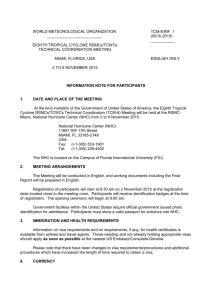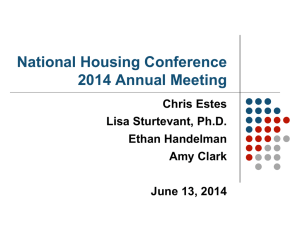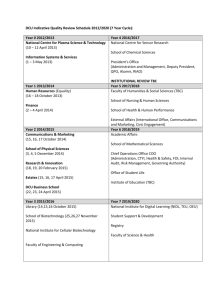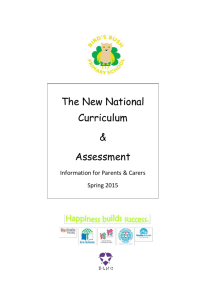NHC Four Year Business Plan 2014/15 - 2017/18
advertisement
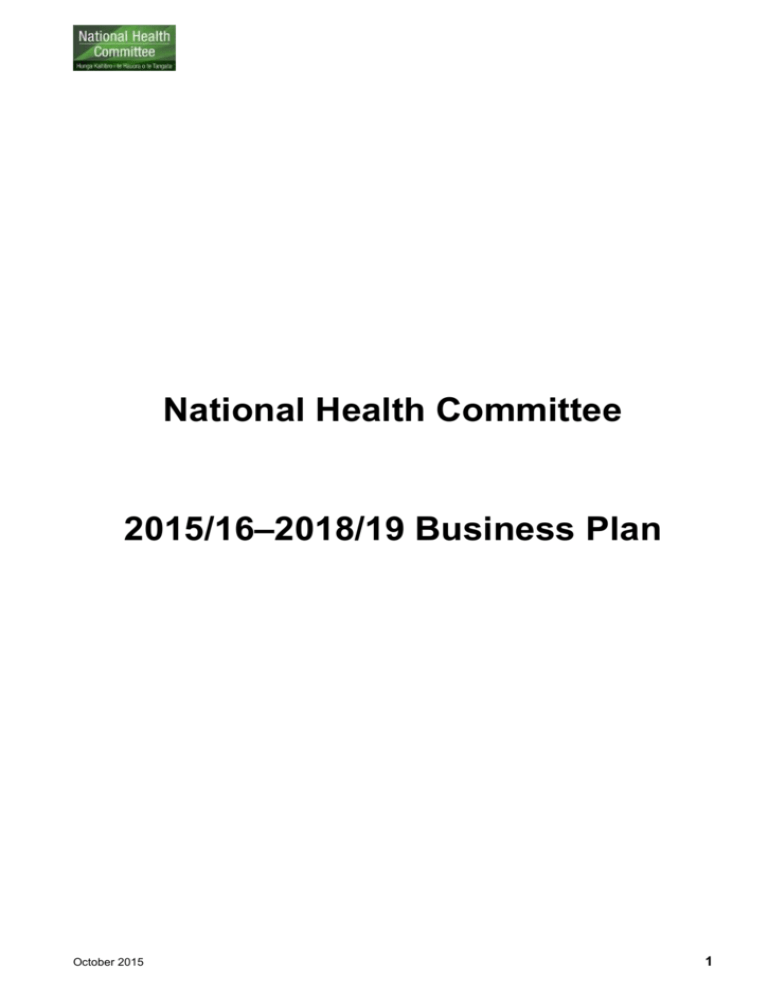
National Health Committee 2015/16–2018/19 Business Plan October 2015 1 ISBN 978-0-947491-62-8 HP 6347 Published in October 2015 by the National Health Committee PO Box 5013, Wellington, New Zealand. October 2015 2 Contents 1. Introduction 4 1.1 NHC Strategic Direction 4 1.2 Workstreams 4 2. Four Year High Level Work Programme 7 October 2015 3 1. Introduction The 2015/16-2018/19 National Health Committee (NHC) Business Plan has been developed to provide a high level overview of the areas of focus and deliverables the NHC is planning for the next four years. The Business Plan builds on the 2014/15–2017/18 Business Plan and the updated strategic direction described in the NHC’s 2015/16-2018/19 Strategic Plan (refer below). It acknowledges the progress against the previous year’s business plan outputs, the lessons learned through this process (including the increased length of time required to complete a proactive assessment), and includes the kind of outputs we would expect to deliver during the four year period. The Business Plan will be reviewed annually. The Business Plan will also be revised in due course to ensure consistency and alignment with the New Zealand Health Strategy. 1.1 NHC Strategic Direction The 2015/16 – 2018/19 National Health Committee Strategic Plan includes the following strategic framework (Figure 1) which is used as the basis to inform the Business Plan, specifically the three NHC strategies proposed. Note the previous business plan was structured on outcomes and outputs which have been incorporated within the NHC’s updated strategic focus and goals structure. This updated approach is intended to provide more clarity regarding the NHC’s strategic intentions. The NHC’s strategic focus for the next four year plan is to ‘Lead and Influence Sector Change’. Creating and sustaining system change by leading development of recommendations for technology and interventions that are implementable to achieve sustainable health outcomes. This strategic focus is supported by two key goals: 1. Finding the Balance - Assist the Sector improve clinical outcomes and meet immediate fiscal challenges while providing the medium to long view on improving patient and population outcomes and sector sustainability 2. Applying the Full Extent of the NHC Mandate - Strengthening the NHC mandate for prioritising the most cost effective health technologies. Developing an approach which generates buy-in from all stakeholders and is implementable, provides a logical and practical sequence of actions and utilises both formal and informal levers to achieve the best outcome. 1.2 Workstreams Each year we focus our assessment process into three to four workstreams (two or three workstreams for proactive assessments and multiple workstream for reactive assessments). The tiered assessment process takes longer than one financial year, and therefore each workstream is at a different phase of the process. Therefore each year some workstreams will come to a conclusion with recommendations presented to the Minister of Health for implementation, and new workstreams will start with the Tier 1 strategic overview assessment. Figure 2 describes the planned timing for the reactive and proactive workstreams over the next four years. It describes how some of the reactive referrals have been incorporated in the proactive work programme. During this four year period there will be a transition from the disease focussed assessments (eg ischaemic heart disease) to a population focus (eg frail elderly). The subsequent evolution to a systems focus will begin with the assessment of musculoskeletal and eye, the test case for the model of care approach. This will potentially impact the current intended analyses for October 2015 4 neoplasm / endocrine, digestive / mental health and hepatobiliary / kidney and urinary. The NHC will review planned workstreams annually as part of the planning process. Figure 1: Strategic Framework Whole of Government Outcomes Improved patient & population health outcomes Sector Outcomes Sector Priorities NHC Impact Clinical Leadership Improved patient & population outcomes NHC Strategy NHC Strategic Functions Sector Level Intervention Level October 2015 Improved population health & wellbeing Most effective mix of clinical services delivered Improved sector sustainability Financial sustainability Whole of government systems thinking Leading & influencing sector change Innovate Better Public Services Sector contribution to economic growth Integration Health Targets Bending the cost curve Finding the balance Identify / Prioritise / Advise / Recommend Improved economic growth for NZ Contribution to economic growth through innovation Applying the full extent of the NHC mandate Implement Monitor / Evaluate Model of care approach – integrated prioritisation across the continuum of clinical and business decision making Prioritising the best mix of clinical services to meet current & future need and maximise health outcomes 5 Figure 2 Proposed Timing of Workstreams Cardiac Cluster Cardiovascular ->Ischaemic Heart Disease Respiratory -> Chronic Obstructive Pulmonary Disease Aortic Abdominal Aneurysm Diagnostics -> Haematuria Genetics Frail elderly Musculoskeletal / Eye Age-related macular degeneration, low back pain & IORT 2014/15 Reactive Referrals Neoplasm / Endocrine Hepatobiliary / Kidney and Urinary (TBC) Digestive / Mental Health (TBC) Disease 2013 2014 Population 2015 Models of Care (System) 2016 2017 2018 Key October 2015 2012/13 reactive referral 2013/14 reactive referral Proactive workstream Intended proactive workstream 2014/15 reactive referral 6 2. Four Year High Level Work Programme Strategic Focus: Leading and influencing sector change Creating and sustaining system change by leading development of recommendations that are implementable to achieve sustainable health outcomes. Outcome Outputs Deliverables 2015/2016 Provision of leadership to respond sector challenges October 2015 Support the Sector to develop solutions to sector challenges 2016/2017 Provide the Sector with updates on emergent trends in health Provide the Sector with updates on emergent trends in health Provide the Sector opportunities to discuss future trends and solutions to sector challenges Provide the Sector opportunities to discuss future trends and solutions to sector challenges Apply a pull model for health technology Gain the attention of technology providers and users by using evidence to alter reactive flow of technology to a proactive model Proactive assessment process extended beyond the assessment of level and mix of current services to include new models of care Focus proactive assessment process to identify large and growing spends by condition type beyond the assessment of the level and mix of current services to Measure 2017/2018 2018/19 Review the usefulness of the horizon scanning and discussion opportunities provided to the Sector Revise the provision of sector updates on emergent trends in response to review Sector aware of the emergent trends for prioritisation across the model of care Gain the attention of technology providers and users by using evidence to alter reactive flow of technology to a proactive model Gain the attention of technology providers and users by using evidence to alter reactive flow of technology to a proactive model Gain the attention of technology providers and users by using evidence to alter reactive flow of technology to a proactive model Technology providers and users aware of the NHCs recommendations Continue to focus proactive assessment process on assessment and recommendation of new or revised models of care Review focus on new or revised models of care to ensure it is enabling the achievement of sustainable health outcomes Re-focus and enhance proactive assessment process based on review Assessments, using models of care methodology, will be completed each year. Information provided to the Sector adds value to their processes to enable system change and responses to sector challenges 7 Strategic Focus: Leading and influencing sector change Creating and sustaining system change by leading development of recommendations that are implementable to achieve sustainable health outcomes. Outcome Outputs Deliverables 2015/2016 Measure 2016/2017 2017/2018 2018/19 Complete field evaluations to generate evidence for promising technology related to the musculoskeletal or eye, neoplasm or endocrine (subject to confirmation) work programmes Complete field evaluations to generate evidence for promising technology related to the neoplasm or endocrine and hepatobiliary or kidney and urinary (subject to confirmation) work programmes Complete field evaluations to generate evidence for promising technology related to hepatobiliary or kidney and urinary and digestive or mental health (subject to confirmation) work programmes assessment and recommendation of new or revised models of care Field evaluations to include testing new interventions, feasibility, affordability, and new and revised models of care Complete field evaluations to generate evidence for promising technology related to the diagnostics, musculoskeletal or eye work programmes. Field evaluations underway for IORT, aortic stenosis and bladder cancer diagnostics (2-3 year process) Maintain partnership with the HRC (ie HIP) and CI Research questions arising from tiered assessments, or Sector (following HIP call for proposals driven by NHC strategic work programme and tiered assessments) to be answered in a timeframe which October 2015 Continue field evaluations for IORT, aortic stenosis and bladder cancer diagnostics Review relationship with HRC and CI to ensure they still meet NHC strategic requirements Research questions arising from tiered assessments, or Sector (following HIP call for proposals driven by NHC strategic work programme and tiered assessments) to be Continue field evaluations for IORT, aortic stenosis and bladder cancer diagnostics Refine expectations of relationship with HRC and CI based on review Research questions arising from tiered assessments, or Sector (following HIP call for proposals driven by NHC strategic work programme and tiered Maintain and enhance relationship with HRC and CI Research questions arising from tiered assessments, or Sector (following HIP call for proposals driven by NHC strategic work programme and tiered assessments) to be answered in a timeframe which allows evidence to be incorporated into recommendations Field evaluations will generate evidence for promising technology and system changes related to the strategic work programme Answers to research questions from tiered assessments incorporated into recommendations Research protocols complied with and align to strategic intent Research protocols to 8 Strategic Focus: Leading and influencing sector change Creating and sustaining system change by leading development of recommendations that are implementable to achieve sustainable health outcomes. Outcome Outputs Deliverables 2015/2016 2016/2017 2017/2018 2018/19 allows evidence to be incorporated into recommendations answered in a timeframe which allows evidence to be incorporated into recommendations assessments) to be answered in a timeframe which allows evidence to be incorporated into recommendations be pragmatic, real world, aligned to four domains and iterative Research protocols to be pragmatic, real world, aligned to four domains Contribute to sustainable health outcomes October 2015 Measure Research protocols to be pragmatic, real world, aligned to four domains and iterative Research protocols to be pragmatic, real world, aligned to four domains and iterative Utilise the Health Innovation Partnership $2 million for field evaluation work (HRC $1.34 million), Industry TBA Utilise the Health Innovation Partnership $1.75 million contribution for field evaluation work (HRC $1.16 million), Industry TBA Utilise the Health Innovation Partnership $1.75 million contribution for field evaluation work (HRC $1.16 million), Industry TBA Utilise the Health Innovation Partnership $1.75 million contribution for field evaluation work (HRC $1.16 million), Industry TBA Health Innovation Partnership funding fully utilised Undertake innovation evaluations Complete Innovation evaluations to support health’s contribution to economic growth Complete Innovation evaluations to support health’s contribution to economic growth Complete Innovation evaluations to support health’s contribution to economic growth Complete Innovation evaluations to support health’s contribution to economic growth Contribution to economic growth quantified and reported for each successfully implemented innovation Consistent delivery of clinically effective, ethically sound, socially acceptable and implementable technologies and Analyse and assess using the accountability for reasonableness principles and decision making Analyse and assess using the accountability for reasonableness principles and decision making Review decision making criteria to confirm continues to meet objectives and is the most effective and efficiency approach Update approach based on output of reviews NHC recognised for transparent decision making processes Assessments completed each year 9 Strategic Focus: Leading and influencing sector change Creating and sustaining system change by leading development of recommendations that are implementable to achieve sustainable health outcomes. Outcome Outputs Deliverables 2015/2016 interventions Contribute to the financial sustainability of the Sector Increased sector participation in prioritisation criteria across four domains criteria across four domains Recommendations have input from stakeholders to ensure they are implementable and unintended consequences minimised Recommendations have input from stakeholders to ensure they are implementable and unintended consequences minimised Notional budget releasing value to the Sector through cost avoidance, efficiencies and reprioritisation Notional budget socialised with sector to validate methodology and test utility Notional budget approach finalised and introduced Prioritisation capacity and capability in the Sector is maximised Establish the National Prioritisation Reference Group (NPRG) Review released value mix of budget and non-budget % Support the NPRG to assist the NHC to grow national capability and capacity for: prioritisation assessment implementation October 2015 2016/2017 Increase % contribution of efficiencies and reprioritisation Continue to support the NPRG to assist the NHC with prioritisation, assessment and implementation Measure 2017/2018 2018/19 available are analysed using four domain, eleven decision making criteria, and implementation framework and models of care methodology Review approach to stakeholder input Notional budget first year Notional budget second year Increase % contribution of efficiencies and reprioritisation Increase % contribution of efficiencies and reprioritisation Review effectiveness of the NPRG for the members and NHC including participation levels, quality of advice and overall satisfaction. Continue to support the NPRG to assist the NHC with prioritisation, assessment and implementation Notional balanced budget development achieved Target and reporting agreed and implemented National prioritisation group established and functioning as per terms of reference Quality of NPRG advice Refine terms of reference and work programme based on review findings. 10 Strategic Focus: Leading and influencing sector change Creating and sustaining system change by leading development of recommendations that are implementable to achieve sustainable health outcomes. Outcome Outputs Deliverables 2015/2016 Assist sector to develop knowledge and skills to contribute to/ undertake national, regional and local prioritisation / reprioritisation Annually update a four year Business Plan October 2015 Develop NHC staff capabilities and provide opportunities for sector staff to work in the NHC to build sector capability 2016/2017 Respond to requests for prioritisation assistance NHC staff development plan implemented Continue to provide opportunities for sector staff to work in the NHC to build sector capability Measure 2017/2018 Hold national workshops for the Sector on core prioritisation processes 2018/19 Support implementation of national plan Opportunities for sharing resources between the Sector and NHC undertaken Increased understanding of prioritisation core processes Work with HWNZ on national plan for skills improvement NHC capacity and capability extended Demonstrate best practice – provide evidence, utilise international partnerships, provide prioritisation advice and feedback to the Sector, and evaluate and review NHC prioritisation process Demonstrate best practice – provide evidence, utilise international partnerships, provide prioritisation advice and feedback to the Sector, and evaluate and review NHC prioritisation process Demonstrate best practice – provide evidence, utilise international partnerships, provide prioritisation advice and feedback to the Sector, and evaluate and review NHC prioritisation process Demonstrate best practice – provide evidence, utilise international partnerships, provide prioritisation advice and feedback to the Sector, and evaluate and review NHC prioritisation process DHB satisfaction Consult on four-year strategic and operational plan annually (December– March) Consult on four-year strategic and operational plan annually (December– March) Consult on four-year strategic and operational plan annually (December– March) Consult on four-year strategic and operational plan annually (December– March) Considered feedback received from sector on plans each year 11 Strategic Focus: Finding the Balance Assist the Sector improve clinical outcomes and meet immediate fiscal challenges while providing the medium to long view on improving patient and population outcomes and sector sustainability. Outcome Sector’s areas of concern are addressed through reactive referral round Outputs Annual reactive referral round for the health sector Deliverables Measure 2015/2016 2016/2017 2017/2018 2018/19 Quality improvement process identified by Health Sector Forum from 2014/2015 referral round applied to 2015/2016 process including realignment of timing of process to better support DHB planning cycles Annual referral round completed incorporating quality improvements Annual referral round structured to focus on longstanding systems issues Annual referral round continues to focus on systemic challenges for the Sector Complete assessments from reactive referrals. Complete assessments from reactive referrals. Complete assessments from reactive referrals. Complete assessments from reactive referrals. Genetics related reactive referrals incorporated in genetics proactive workstream T2 assessments to be completed for reactive referral rounds prior to T3 assessments being undertaken. T2 assessments to be completed for reactive referral rounds prior to T3 assessments being undertaken. T2 assessments to be completed for reactive referral rounds prior to T3 assessments being undertaken. Frail elderly reactive referral, first T2 assessment in the transition from disease to population groups, underway Tier 3 assessment papers to underpin recommendations. Tier 3 assessment papers to underpin recommendations. Tier 3 assessment papers to underpin recommendations. T2 assessments to be completed for reactive referral rounds prior to T3 assessments being undertaken. Annual referrals topics increasingly reflect deep seated systems issues Quality improvement incorporated in process DHB satisfaction with process and outcome Complete frail elderly workstream (or continue depending on assessment findings and agreed project plan) Tier 3 assessment papers to underpin October 2015 12 Strategic Focus: Finding the Balance Assist the Sector improve clinical outcomes and meet immediate fiscal challenges while providing the medium to long view on improving patient and population outcomes and sector sustainability. Outcome Outputs Deliverables 2015/2016 2016/2017 Measure 2017/2018 2018/19 recommendations. Proactive assessment process results in implementable recommendations Proactively prioritise using tiered business case approach that describes the model of care Implement tiered business case approach to drive stakeholders to engage and lead consistent, sustainable and measurable implementation for their organisations Continue tiered business case approach Complete Tier 1 comparative analysis of programme budget spends for musculoskeletal and eye programme budget spends Complete Tier 1 comparative analysis (current plan Neoplasm and Endocrine to be reviewed during 2016/17 planning) programme budget spends Complete Tier 1 comparative analysis (current plan Hepatobiliary and Kidney and Urinary to be reviewed during 2017/18 planning) programme budget spends Recommendations for particular disease states for Tier 2 and 3 analysis in 2017/18 Recommendations for particular disease states for Tier 2 and 3 analysis in 2018/19 Recommendations for particular disease states for Tier 2 and 3 analysis in 2016/17 Genomics, genetics and epigenetics workstream incorporating work to date in diagnostics (haematuria / bladder cancer testing), reactive referrals and international partnerships October 2015 Continue tiered business case approach Review tiered business case approach Potential unintended consequences minimised Assessment process timeframes reduced Tier 1, 2 and 3 assessments undertaken as planned Complete Tier 1 comparative analysis (current plan Digestive and Mental Health to be reviewed during 2018/19 planning) programme budget spends Recommendations for particular disease states for Tier 2 and 3 analysis in 2019/20 Assessments undertaken in a timeframe to maintain sector and market relevance Assessments to identify technologies which can provide more clinically effective and cost effective care to patients. Assessments to identify technologies which require field evaluation before clinical and cost effectiveness can be ascertained. Assessments aligned 13 Strategic Focus: Finding the Balance Assist the Sector improve clinical outcomes and meet immediate fiscal challenges while providing the medium to long view on improving patient and population outcomes and sector sustainability. Outcome Outputs Deliverables 2015/2016 2016/2017 Measure 2017/2018 2018/19 underway with agreed project plan Complete Tier 2 musculoskeletal or eye assessment with implementation framework and quality framework Complete Tier 2 Neoplasm or Endocrine assessment Completer Tier 2 Hepatobiliary or Kidney and Urinary assessment Complete Tier 2 Digestive or Mental Health assessment Complete Tier 3 Neoplasm or Endocrine assessments Completer Tier 3 Hepatobiliary or Kidney and Urinary assessments Continue genomics, genetics and epigenetics workstream based on project plan Complete Tier 3 IHD and COPD assessments October 2015 Complete Tier 3 musculoskeletal or eye assessments 14 Strategic Focus: Applying the full extent of the NHC mandate Strengthening the NHC mandate for prioritising the most cost effective health technologies Outcome Sector engagement contributes to improved implementation of recommendations Outputs Strategic and collaborative relationships developed and enhanced across central agencies, health and disability service providers, industry, funders and evidence developers and other key stakeholders Deliverables Measure 2015/2016 2016/2017 2017/2018 2018/19 Maintain and enhance sector relationships through regular communication and interface with the NHC Maintain and enhance sector relationships through regular communication and interface with the NHC Maintain and enhance sector relationships through regular communication and interface with the NHC Maintain and enhance sector relationships through regular communication and interface with the NHC Strategic communications plan developed focused on sector awareness and maintaining the integrity of the NHC brand Strategic communications plan implemented Review strategic communications plan to ensure it’s achieving the desired result with the Sector Improve the strategic communications plan to better meet the NHC’s requirement for sector awareness and maintaining the integrity of the NHC brand Quarterly communication with key stakeholders including: MoH and NHB DHBs, NZHIH and PHOs PHARMAC and hA/HBL Treasury and MBIE HRC and CI Universities colleges industry and public Implementation of key activities from strategic communications plan NHC brand visible and integrity maintained Collaborative relationship agreements formalised with: DHBs PHARMAC and hA/HBL Relationships developed and October 2015 Collaborative relationship agreements formalised with other agencies Maintain & monitor agreements Review agreements to ensure still useful to all parties Maintain & monitor agreements Relationships developed and Relationships developed and Re-negotiate agreements where required to ensure mutually desired outcomes are achieved Benefits identified in collaborative agreements achieved Other parties satisfied with progress achieved Relationships developed and 15 Strategic Focus: Applying the full extent of the NHC mandate Strengthening the NHC mandate for prioritising the most cost effective health technologies Outcome Outputs Deliverables 2015/2016 2017/2018 2018/19 maintained: maintained: maintained: maintained: Use of formal and informal levers contributes to improved implementation of recommendations 2016/2017 Measure Academic consortia Industry International Consumers Sector commitment to introducing consistently or not introducing emerging technologies based on the NHC recommendations Gain sector commitment to introducing consistently or not introducing emerging technologies Recommendations are successfully implemented Implementation framework established Academic consortia Industry International Consumers Seek continued commitment from Sector Academic consortia Industry International Consumers Seek continued commitment from Sector Academic consortia Industry International Consumers Seek continued commitment from Sector Technologies introduced, expanded or excluded based on NHC recommendations Technologies held while being assessed by NHC Sector engaged in implementation approach Monitoring and evaluation framework established for implementation of recommendations Review progress to date and ways to improve implementation framework Implementation framework incorporates improvements Recommendations delivered each year describing the most appropriate model of care for the population group Recommendations implemented as per NHC advice Implementation considered during every phase of the NHC workflow process Implementation performance metrics October 2015 16 Strategic Focus: Applying the full extent of the NHC mandate Strengthening the NHC mandate for prioritising the most cost effective health technologies Outcome Outputs Deliverables 2015/2016 2016/2017 Measure 2017/2018 2018/19 monitored and used for continuous improvement Cross agency opportunities implemented Opportunities to add value to other central government agencies explored Opportunities to add value to other agencies identified and trialled as appropriate Trials evaluated and embedded across the Sector where successful Further opportunities to add value to other agencies explored and implemented as appropriate Benefits identified by opportunities achieved Options to increase leverage implemented Explore options to increase the NHC’s leverage to generate efficiency, value for money and accountability across the system Implement levers identified Monitor and evaluate levers implemented Refine use of levers as appropriate Increased efficiency, value for money and accountability across the Sector achieved Change management best practice implemented Develop change management plan based on best practice Implement and monitor change management plan to effect system wide change Review and refine change management plan to ensure it continues to enable system wide change Continue to implement updated change management plan System wide change is embedded and sustained Monitor and evaluate 2014/15 recommendations and implementation are monitored in an efficient manner to assess effectiveness / continued relevance. Diagnostics / Genomic recommendations and implementation are monitored in an efficient manner to assess effectiveness / continued relevance. Musculoskeletal or Eye recommendations and implementation are monitored in an efficient manner to assess effectiveness / continued relevance. Neoplasm or Endocrine recommendations and implementation are monitored in an efficient manner to assess effectiveness / continued relevance. Regular monitoring of recommendations implemented by the Sector undertaken Recommendations for process improvement made to inform 2017/18 projects. Recommendations for process improvement made to inform 2018/19 projects. Recommendations for process improvement made to inform 2019/20 projects. Recommendations, IHD and cardiac cluster and other reactive referrals outputs to inform October 2015 Report outlining process improvements and future opportunities based on review of implementation of recommendations 17 Strategic Focus: Applying the full extent of the NHC mandate Strengthening the NHC mandate for prioritising the most cost effective health technologies Outcome Outputs Deliverables 2015/2016 2016/2017 Measure 2017/2018 2018/19 provided to the Sector process improvement for 2016/17 projects. Quality Framework October 2015 Quality framework established based on: Agreed quality goals and philosophy current and best practice to reinforce quality assurance and improvement throughout the NHC workflow performance measurement framework engagement with stakeholders throughout the process Implement quality framework to reinforce quality throughout the NHC workflow Review and refine quality framework based on sector feedback and best practice Continue to refine quality framework as required Quality evident in all aspects of the NHC workflow and strategic functions 18

